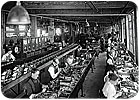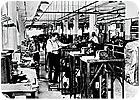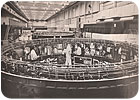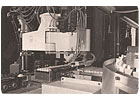
International Business Machines Corp. (IBM) is celebrating its centennial this month. The company has a long history of plant floor innovation and cutting-edge manufacturing.
Today, most people associate IBM with computers, but through the years, its state-of-the-art factories have mass-produced a wide variety of products, including clocks, dictating machines, electric meat choppers, microphones, scales, mechanical tabulating machines and typewriters.
Big Blue traces its roots to the International Time Recording Co. (ITR) of Endicott, NY, which made mechanical clocks for factories, warehouses, office buildings and department stores. In 1911, ITR merged with two other companies-the Computing Scale Co. of Dayton, OH (a manufacturer of commercial scales) and the Tabulating Machine Co. (a Washington-based manufacturer of mechanical tabulators)-to create the Computing-Tabulating-Recording Co. (C-T-R).
In 1924, the conglomerate was renamed International Business Machines. By 1940, it was the largest office-machine manufacturer in the world, thanks to innovative products, such as the 405 electric punched card accounting machine, which was introduced in 1934. The device was an adding, subtracting and printing machine that printed complete reports from punched cards.
The humble punched card played a key role in IBM’s early growth and success. In 1928, Big Blue introduced a new version of the punched card that featured rectangular holes and 80 columns. It could only be used on IBM machines and vice versa. As late as the mid-1950s, punched card sales made up 20 percent of IBM’s revenues and 30 percent of its bottom line.

In IBM's early years, the company manufactured recording clocks, which were used in factories, warehouses and other enterprises.
Typing Lessons
ASSEMBLY has chronicled many of IBM’s manufacturing exploits over the last six decades. When the magazine debuted 53 years ago, many of Big Blue’s products still contained hundreds of mechanical components, such as gears, springs, wheels, sprockets and levers. The company’s Electric Typewriter Div. assembled its one-millionth machine in 1958 and engineers were secretly working on a revolutionary new product.Two years later, assemblers at IBM’s Lexington, KY, plant began producing the Selectric typewriter. It featured an innovative golf-ball shaped typing head that replaced the traditional type bar carriage and eliminated pesky jams.
The manufacturing facility expected to make 20,000 Selectric typewriters in its first year. However, by the end of 1961, it had orders for 80,000. During the next 25 years, the Selectric was a common sight on office desks around the world, with more than 13 million units produced.
With 2,800 parts, many designed from scratch, the Selectric was a radical departure for IBM, which had been in the typewriter business since the 1930s and was already the market leader. It took seven years to work out the manufacturing and design challenges before the first Selectric was ready for sale.
Today, of course, IBM is synonymous with computers. But, back when the first typewriter-produced issue of ASSEMBLY appeared in the late 1950s, computers were still in their infancy and they took up entire rooms.
An early issue of the magazine contained a news item about how IBM engineers had recently unveiled the AN/FSQ-7, which consisted of two complete Whirlwind II computers installed in a four-story building. It used more than 50,000 vacuum tubes. The 275-ton, $238 million machine required an army of 60 employees for round-the-clock maintenance, such as replacing several hundred vacuum tubes that failed each day or tending to finicky punched cards.

Assemblers attach wiring and relay cabinets to Type 070 vertical sorters at IBM's factory in Endicott, NY, shortly after World War I.
Automation Pioneers
Plant floor automation has always played a key role in IBM’s success. For instance, in 1959, the world’s first fully automatic production line for transistors was designed by the company’s engineers in Poughkeepsie, NY. It produced and tested 1,800 individual transistors an hour. That key breakthrough led to a steady evolution of bigger, better and faster computers during the 1960s, such as the legendary System/360.Transistors and printed circuits were attached onto cards that were plugged into large frames housed in a big cabinet, which spawned the term “mainframe.” ASSEMBLY’s March 1961 issued contained a news item about how IBM engineers created an automated plug assembly machine to “achieve dependable performance, low unit cost and automatic assembly.”
By redesigning the plug nose for automatic diecasting, IBM was able to “take full advantage of automatic assembly of patch cord plugs” that were inserted in varying patterns into interchangeable program boards. The automatic plug assembly machine featured a vibrating hopper that fed four components and lined them up for assembly at a rate of 140 per minute.
The July 1965 issue of ASSEMBLY quoted Jarrier Haddad, IBM’s director of technology and engineering, on the emerging role of automation in manufacturing and design. “The rise in automation does not allow a separation of product design engineering from the manufacturing process,” said Haddad, who was responsible for the technical development and design of IBM’s 701 electronic data processing machine in the early 1950s. “Automation is influencing the end result of product development . . . .
“We must, in fact, compromise the product design so that the production automation which is possible minimizes the total program cost,” Haddad pointed out. “Today, we can maximize production efficiency to a greater degree than heretofore possible and also produce better products at the same time.”
A few pages later, that same issue of ASSEMBLY contained a cover story about “Automatic Wiring of Computer Panels” at IBM’s Endicott and Poughkeepsie plants, in addition to newer facilities in Rochester, MN, and San Jose, CA. The article explained how “at a rate of 1,000 per hour, complete computer back panels are wired automatically in approximately 2 hours.”
The back panels contained metal pins, 0.75-inch high, into which electronic component filled circuit cards were plugged. Each panel used an average of 1,000 wires and the pins were connected by 24 gauge and 30 gauge wire. The wire-wrap machines automatically positioned the back panels and then cut, stripped and wrapped wire around the terminal pins.
A computer calculated wire routing according to a set of rules, which considered parameters such as noise level and wire build up. Instructions were fed into the wire-wrap machine on punched cards that each contained “the information necessary to attach one piece of wire at both ends.”
The cards plotted tool movements on a 0.125-inch Cartesian grid. Six different tool heads were coordinated with a four-position rotating table to execute 40 different wiring patterns. This system, which included an error-proofing device, allowed the wire-wrap machines to handle 98 percent of the wires on an average panel. The remaining 2 percent of the connections involved nonstandard wires that were manually installed.
Engineers at IBM also harnessed computer technology to mass-produce microcircuit logic modules and printed circuit boards (PCBs). “A few years ago, the idea of using computers to make other computers might have seemed pretty ‘far out,’” proclaimed an article in the November 1965 issue of ASSEMBLY. “Today, however, this concept has become a reality at IBM’s plants located at East Fishkill and Endicott, NY.”
The article explained how “computers are used in virtually every phase of manufacturing to coordinate a highly integrated system that extends from design engineering to the final testing of completed assemblies.” For instance, at the Endicott PCB plant, design engineering data, such as circuit layout, hole patterns, interconnections, part identifications and quality testing requirements, were converted to computer language and used throughout the manufacture of boards.
In the May and June 1966 issues of ASSEMBLY, the manager of IBM’s Poughkeepsie factory explained how computers could improve efficiency on the plant floor. He claimed that “computers are becoming much more closely linked with both engineering and manufacturing.” The plant used state-of-the-art computerized manufacturing to design and produce the circuit boards used in the System/360 mainframe, which debuted in 1964.

Computers helped keep tabs on the mind-boggling array of operations involved in assembling rockets, such as this 21-foot-wide Saturn instrument unit.
Plant Floor Innovation
Tabulating machines and computers built by IBM played a key behind-the-scenes role in achieving several 20th century milestones, such as the creation of the Social Security Administration, the Allied victory in World War II, the Space Race and the spread of commercial airline travel.An article in the June 1967 issue of ASSEMBLY explained how computers helped keep tabs on the mind-boggling array of operations involved in assembling NASA’s massive Saturn launch vehicles. For instance, IBM engineers developed variable assembly sequencing technology to track more than 2,400 components used in the instrument unit that helped guide, navigate and control the rockets that took man to the moon.
Each ring-shaped unit was 3 feet tall and 21 feet in diameter. The hardware was sandwiched between the last Saturn propul-sion stage and the Apollo spacecraft that housed three astronauts.
The production planning and scheduling system developed to meet this complex assembly operation was dubbed VAST (variable assembly sequencing technique). Engineers at IBM’s Space Systems Center in Huntsville, AL, used it to track the production status of 500 critical parts on a real time basis.
Production status data was relayed from the assembly floor by manufacturing analyzers to production analyzers. The ASSEMBLY article, written by IBM’s project engineer, explained how the “sequential coding methods for identifying mating and gating parts makes it possible to see the overall relationships of all the parts and assemblies required.
“The reports provided by VAST have given management the data needed for accurate decision making and smooth coordination of assembly operations and engineering changes,” the engineer pointed out. “The learning time for all assembly technicians has been significantly reduced by providing complete and accurate instructions that can be easily and quickly obtained when needed.”
Daily work schedule reports, which listed the parts to be used in each instrument unit according to assembly sequence, were produced automatically. Operators and technicians were able to quickly access the work instructions required for assembling each part and subassembly. “This reference method saves time, since technicians are able to find the assembly and installation information required very quickly without sorting through stacks of paper or files,” the IBM engineer explained.
ASSEMBLY reported on another IBM innovation in its March 1973 issue. Manufacturing engineers at the company’s System Product Div. plant in Kingston, NY, developed a system for making error-free connections to thousands of terminal pins on computer panels. The light-guided STEP (system for test and plug) reduced plugging errors by 99 percent. It was used to assemble System/370 computers, which used many different cabling patterns because of customer options.
Assemblers used two arm-like light probes, each moving in an x, y or z axis, to locate and identify the correct point for the next connection. At the connection point, the light shined through the semitransparent circuit board, producing a halo of light on the other side, which showed operators exactly where to make the connection. The system then performed a 100 percent electrical test of the continuity. The probe automatically moved to the next connection only if the connection was correct.

An IBM 7535 robot installs keyboard buttons at the Lexington, KY, plant in the mid-1980s.
Robotic Revolutionaries
In the 1970s and early 1980s, IBM was a major force in cutting-edge robotics technology. Engineers at the company’s R&D laboratory in Mohansic, NY, first embarked on a development program in the mid-1960s. The goal was to create flexible, computer-based tools that could perform complex, varied and repetitive assembly tasks quickly and accurately.In 1972, a robot technology group was formed at the Watson Research Center in Yorktown Heights, NY. Within a year, engineers built their first robot and proprietary software to run it. Several years later, two-arm robots were used to test backplane wiring on IBM 3033 computers at the Poughkeepsie plant.
In 1983, IBM unveiled the 7565 Manufacturing System, which was used on the company’s Displaywriter assembly line in Austin, TX. Controlled by an IBM Series/1 computer, the system was hailed as a “versatile productivity tool” for a variety of industries, including automotive, aerospace, appliance and electronics.
An operator could program the system through either the keyboard-display or a programmable, handheld teach pendant. The 7565 was programmed in AML (A Manufacturing Language), a powerful, easily used programming language developed by IBM engineers specifically for robotic applications.
In 1986, ASSEMBLY visited IBM’s Lexington plant, which was in the midst of a major transition. The facility still manufactured typewriters, but it was also assembling more and more office printers. The plant had a long history of building labor-intensive electromechanical devices, but was converting to automated production.
Several years after embarking on its new business plan, the Lexington plant had transformed 65 percent of its manufacturing floor from manual to automated processes. As part of its $350 million investment in the plant, IBM unveiled a wide variety of new assembly tools and processes. For instance, it used computer simulation to design modular components and evaluate throughput without the use of traditional physical models or prototypes.
Design and manufacturing engineers worked closely with each other to ensure that “common parts could be manufactured on common automated lines.” Each new product was divided into major parts or modules, with each assigned its own manufacturing area and project team.
And, the Lexington plant streamlined its supplier base, going from 678 different vendors to only 60 suppliers. Strict quality control requirements were placed on incoming parts and materials from suppliers that adhered to new just-in-time delivery schedules.
Robots also played a key role in the plant’s transition. For instance, new printers were designed to be assembled by flexible, programmable robots. According to the cover story in the February 1986 issue of ASSEMBLY, “the keyboard itself is the best example of the design for automation concept. The previous-generation keyboard has about 370 discrete part numbers, contains 65 screws and is assembled by people.
“The new membrane keyboard has 11 unique part numbers, contains no screws and is assembled almost entirely by robots,” the article pointed out. “Automatic guided vehicles deliver parts to the keyboard line from an automated storage and retrieval system to the point of use.”
The keyboard assembly line featured 28 IBM 7535 manufacturing systems, which turned out a completed keyboard every 30 seconds. According to the ASSEMBLY article, “the automated manufacturing modules at IBM Lexington are capable of producing nearly any product that fits within a 26 by 22 by 18 inch work envelope.
“The automated systems are designed such that they could be reconfigured to accommodate another product at a cost of from 10 percent to 15 percent of the original capital investment, most of which would be needed for software and tooling,” the article concluded. “Hence, the factory is well positioned to respond to changing demands in an increasingly competitive marketplace.”
IBM's flagship factory in Poughkeepsie, NY, was the recipient of ASSEMBLY magazine's 2008 Assembly Plant of the Year award.

